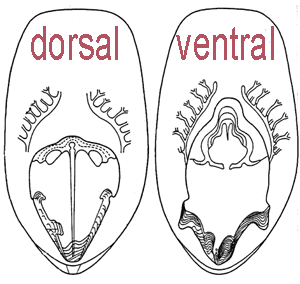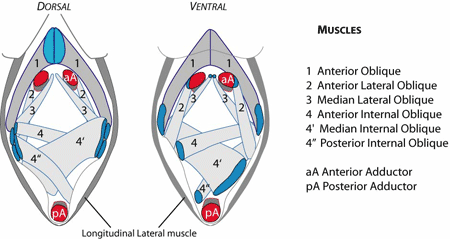 |
|
||||||
|
Genus Credolingula Smirnova & Ushatinskaya, 2001 |
| [Type-species = C. olferievi ] |
| Shell elongate oval, weakly biconvex, with subparallel lateral margins and rounded sublinear anterior margin. At each valve, two weak plications running from urabo to anterolateral corners detine low median fold. Pseudointerareas faint. Ventral valve: visceral field rounded triangular, extending half valve length. Posterior adductor scar trapezoldal, set close to fused posterior oblique and anterior oblique muscle scars. Anterior adductor scars can join near visceral field anterior margin. Two narrow subparallel furrows run from posterior margin through posterior adductor scar to visceral field of anterior margin. Dorsal valve: visceral field occupies about two-thirds of valve length. Posterior adductor scar horseshoe-shaped, joined with extemal and intemal oblique muscle scars into one structure. Anterior adductor scars adjoin anterior oblique muscle scar. Median slit developed to different degree. |
| Cretaceous
Occurrences: Russia (Dagestan; Belgorod region; Saratov and Volgograd regions; northern Caucasus) - S America (Patagonia, Chile). Diagnosis from Smirnova & Ushatinskaya (2001) |
|
|
|
The references of this page are:
|
|
Holotype: PIN, no. 4796/1. Type locality: Stoilo Quarry 10 km W frorn the town of Staryi Oskol, Belgorod region (Russia). Type horizon: Lower Cretaceous, probably Lower Albian. Etymology:. Diagnosis - (Smirnova & Ushatinskaya, 2001) Shell elongate oval in outline or slightly pentagonal with sublinear to rounded sublinear short anterior margin. Lateral margins are subparallel. The shell tapers slightly anteriorly. |  |
|
Shell interior. In the ventral valve, the visceral field occupies about half of its length. It is triangular posteriorly and rounded anteriorly. The large posterior adductor scar is irregular-trapezoidal with a beveled anterior margin, so that its left side is more extended anteriorly. It is separated by a sharp plication from the intermediate and posterior oblique muscle scars, which run nearly parallel to the posterior and posterolateral valve margins for a fairly long distance. The right and left intermediate and posterior oblique muscle scars are slightly différent. The left intermediate oblique muscle scar is narrow, strongly prolate, and connected through the anterior constriction with the anterior oblique muscle scars. On the right side, there is a well-defined scar of an odd internal. oblique muscle. It parallels the posterior oblique muscle scar. These two muscle scars may join, or may be separated by a thin narrow ridge. The anterior oblique muscle scars continue anteriorly to the posterior ones. They vary in outline from semicircular with a straight posterior margin to oval prolate with extended inner margins and a concave posterior margin. The anterior adductor scars are set on a semicircular platforin near the visceral field anterior margin. They are transversely prolate with their long axes directed 45-55° to the plane of symmetry. A pair of thin subparallel grooves arises anteriorly to the pseudointerarea and run longitudinally through the entire visceral field. The rounded anterior end of the strip, which is bordered by grooves, may be separated by a constriction. The main mande canals are strongly curved inwards and bear a few bifurcated tips. | |
|
Credolingula subtruncata Smirnova & Ushatinskaya, 2001
Holotype: PIN, no. 4796/7. Type locality: Akusha Village, Dagestan. Type horizon: Lower Cretaceous, Upper Albian.
The shell is strongly elongated, moderately convex posteriorly and fiattened anteriorly, with rounded umbo, parallel lateral margins, and rounded-trapezoidal anterior margin. The shell width is equal over its length. Both valves bear weak flat-sloped folds defined anteriorly by two short plications. Fine and relatively wide growth lines alternate. No trace of radial striation. The ventral valve umbo is low, pointed, its apical angle is 95-100°. The pseudointerarea is narrow, the pedicle groove is broad and shallow. The dorsal valve umbo is low, rounded; the dorsal valve pseudointerarea is narrow. | |
|
Credolingula? bagualensis (Wilckens, 1905)
Lingula bagualensis Wilckens, 1905. Holotype: MLP 9006. Type locality: upper valley of the Río Baguales, southern Patagonia, Chile (Magallanes or Austral Basin). Type horizon: Cerro Cazador Formation, uppermost Cretaceous.
| |

